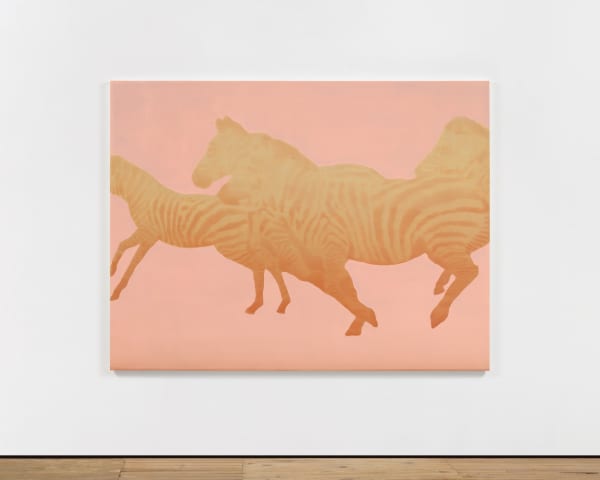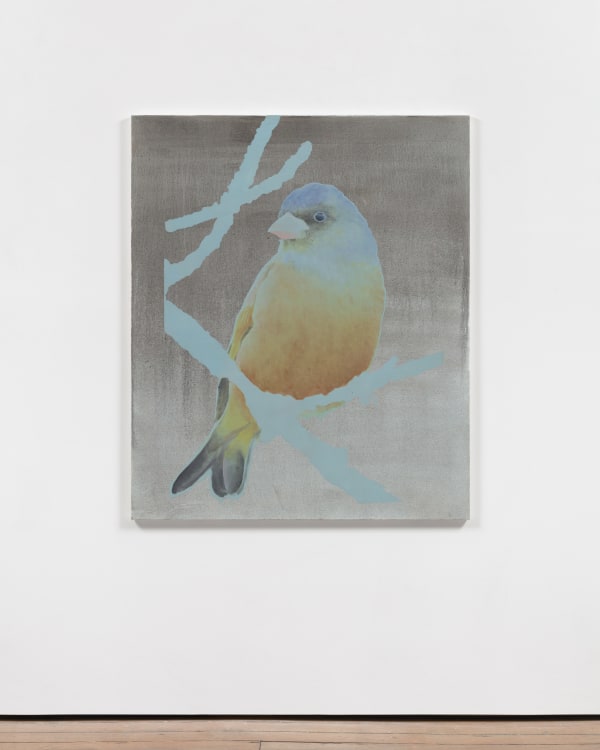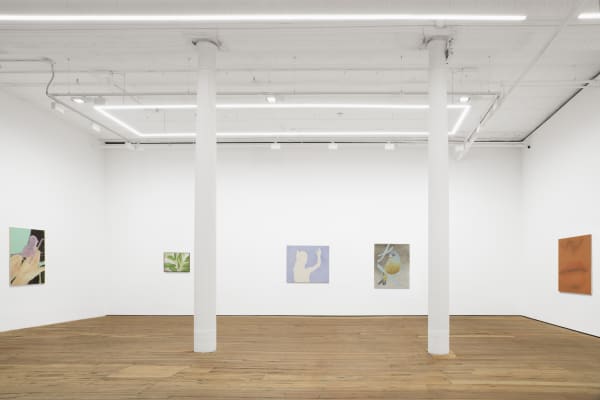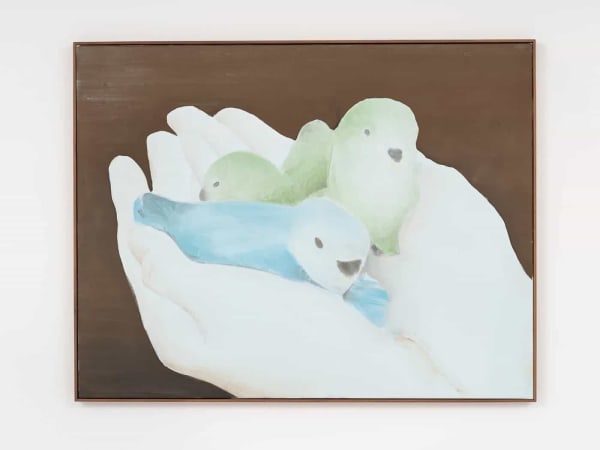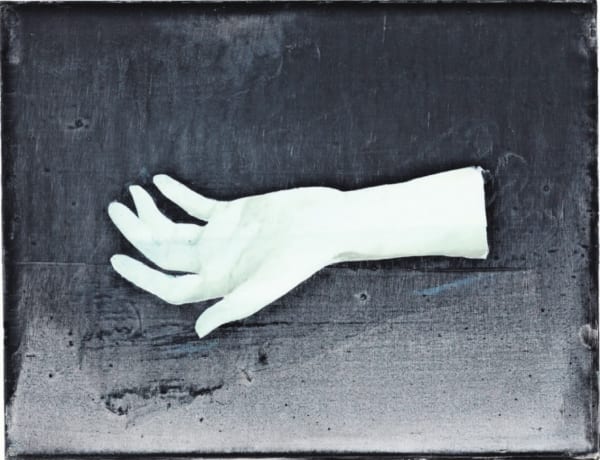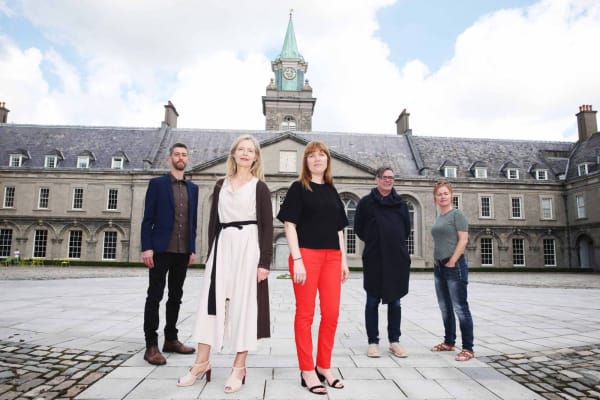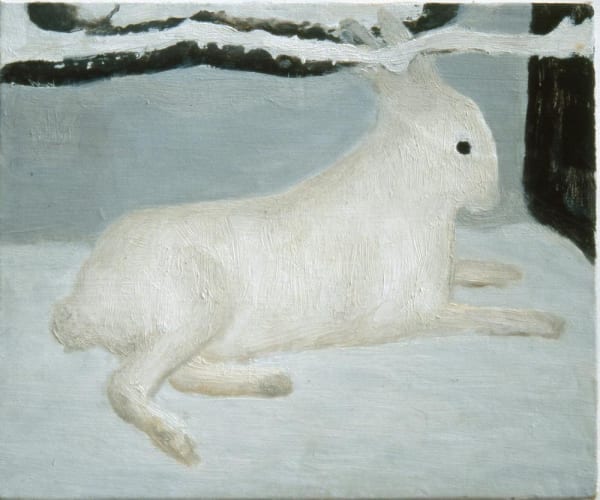Ciarán Murphy’s paintings engage with the entanglement of technological and analogue modes of image-making. Negotiating an infinity of found images, Murphy splices together various source materials, allowing for chance encounters and incongruity to coalesce and collapse seemingly distinct subject matter into resolved compositions. In doing so, he examines and disrupts the dichotomy between original and copy, in favour of painting a blend or ‘mutation,’ asserting the painted medium’s capacity for verisimilitude; its ability to more accurately capture an atmosphere or sensation through approximation rather than direct mechanical reproduction.
Beginning each painting through a process of cutting and collaging different symbols and motifs across the canvas, Murphy allows competing foregrounds and backgrounds to merge unexpectedly. In this way, each painting is realised through the union of visual elements that might be jarring and harmonious in equal measure. Once a desired subject reveals itself, Murphy sets about rendering it in oils, often utilising a range of techniques, from areas of impasto and passages of scumbling, to the scraping and sweeping of paint from the surface, dissolving the absolute clarity of the subject and allowing the image to fade away from easy perception. Murphy’s paintings therefore engage with the phenomenology of sight itself, asking what the human eye can distinguish that a camera lens or computer screen, for instance, might not.
Elusion is not just part of the technique and substance of the painting, but becomes its subject matter too. His paintings are sometimes in series and pairs but also as isolated occurrences, that explore presence and absence; of people, animals, objects and places. Acts of looking or being observed feature prominently, across a suite of paintings depicting an individual figure shielding their eyes, and also a cropped close-up view of hands clasping a pair of binoculars. Murphy is often showing the viewer one thing, whilst obscuring another referent contained outside the boundaries of the canvas, there is an elusive pursuit both for the subject and the viewer, a feeling of suspense.
This allusion to something that is missing, concealed or yet to appear finds a further visual metaphor in a painting of a mound of small letters held within outstretched palms of an unknown figure. It is a painting that internalises this theme of visual equivocation, referencing the equivalent ability of the written and spoken language, like the language of images, to disguise or misdirect the truth. Within a pile of fragmented letters are endless possibilities of meaning that refuse to be unearthed.
Ciarán Murphy (b. 1978 in Mayo, IE) received his BA at the National College of Art & Design, Dublin (IE) in 2003 and his MA in Visual Arts Practices (MAVIS), IADT, Dublin (IE) in 2005. Solo exhibitions include: this appear, GRIMM, London (UK); Solid Gone, GRIMM, Amsterdam (NL); Merrily, merrily, merrily, merrily, Butler Gallery, Kilkenny (IE); The Model, Sligo and Royal Hibernian Academy, Dublin (IE); there, there now, GRIMM, Amsterdam (NL); Hundreds of Nature, GRIMM, New York, NY (US); Plainsight, GRIMM, Amsterdam (NL); A Round Now, Taymour Grahne Gallery, New York, NY (US); The Paradise, Douglas Hyde Gallery, Dublin (IE); All That’s Air Melts Into Solid, GRIMM, Amsterdam (NL); Ciarán Murphy, Douglas Hyde Gallery, Dublin (IE); March, Mother’s Tankstation, Dublin (IE); Ciarán Murphy, Cerealart, Philadelphia, PA (US); and Ciarán Murphy, Kavi Gupta Gallery, Chicago, IL (US).
Selected collections include AzkoNobel Art Foundation, Amsterdam (NL); the Arts Council of Ireland, Dublin (IE); The David and Indrė Roberts Collection, London (UK); Defares Collection, Amsterdam (NL); Irish Museum of Modern Art (IMMA), Dublin (IE); MOVE, Amsterdam (NL); Museum Voorlinden, Wassenaar (NL) and Sanders Collection, Haarlem (NL) among others.
-

Ciarán Murphy
hollow daze January 22 - February 28, 2026 GRIMM 43a Duke Street, St James’s, London (UK)Read more -

Ciarán Murphy
still, weight, thing December 15, 2023 - February 17, 2024 GRIMM 54 White St, New York, NY (US)Read more -

Ciarán Murphy
this appear January 12 - February 25, 2023 GRIMM 2 Bourdon Street, London (UK)Read more -

Ciarán Murphy
Solid Gone January 14 - March 5, 2022 GRIMM Keizersgracht 241, Amsterdam (NL)Read more -

54 White Street | Inaugural exhibition
GRIMM's new gallery in Tribeca March 20 - April 17, 2021 GRIMM 54 White St, New York, NY (US)Join us in March 2021 for the grand opening of GRIMM's new space in Tribeca at 54 White Street. For more further information, please email info@grimmgallery.comRead more -

Ciarán Murphy
there, there now February 1 - March 21, 2020 GRIMM Keizersgracht 241, Amsterdam (NL)Read more -

Away in the Hill
Group Exhibition June 27 - August 2, 2019 GRIMM 202 Bowery, New York, NY (US)Read more -

Ciarán Murphy
Hundreds of Nature October 21 - November 18, 2018 GRIMM 202 Bowery, New York, NY (US)Read more -

Pop-up GRIMM Brussels
Group Exhibition April 18 - May 5, 2018 Ravensteinstraat 44, Brussels (BE)Read more -

Ciarán Murphy
Plainsight January 13 - March 3, 2018 GRIMM Keizersgracht 241, Amsterdam (NL)Read more -

Ciarán Murphy
A Particular Nothing November 27, 2014 - January 3, 2015 Frans Halsstraat 26, Amsterdam (NL)Read more -

Ciarán Murphy
Equipment May 10 - 22, 2011 Frans Halsstraat 26, Amsterdam (NL)Read more -

Ciaran Murphy
All that’s air melts into solid May 8 - June 19, 2010 Keizersgracht 82Read more -

New Paintings
Group Exhibition January 16 - March 6, 2010 Keizersgracht 82Read more
-

Niamh O’Malley and Ciarán Murphy, in Conversation
Osman Can Yerebakan, Elephant, January 5, 2024 -

Chance and Chaos: A Q&A with Ciarán Murphy and Niamh O’Malley
Alexandra Tremayne-Pengelly, Observer, December 11, 2023 -

The Top 5 Art Exhibitions To See This Week
Tabish Khan, FAD Magazine, February 19, 2023 -

Contemporary Artists In The Spotlight 2023 – Nico Kos-Earle
Nico Kos-Earle, Artlyst, January 23, 2023 -

Ciarán Murphy: 'this appear' at GRIMM through February 25th, 2023
D. Creahan, Art Observed, January 18, 2023 -

Meet the artist: Ciarán Murphy
Philip Carton, Business Post, October 28, 2022 -

Ierse krachtschilder (in Dutch)
Edo Dijksterhuis , Het Parool, February 12, 2018 -

Drei Tage in Amsterdam
Simone von Sondermann, Weltkunst, January 30, 2018 -

Interview with Christina Kennedy of IMMA – Hennessy Art Fund
No More Workhorse, November 1, 2017 -

What Lies Beneath: Hare by Ciaran Murphy
Niall MacMonagle, Independent, August 14, 2017 -

In Line of Beauty
Luke Clancy, ArtReview, March 1, 2014 -

Painting is not dead - it's just hard
Gemma Tipton, The Irish Times, August 18, 2012 -

Fluid landscapes that melt and flow into one another
Aidan Dunne, The Irish Times, February 4, 2009 -

Ciaran Murphy
James Yood, Artforum, August 8, 2008 -

Ciaran Murphy
Luke Clancy, ArtReview, September 6, 2006
-

"just weight" (2024) by Ciarán Murphy acquired by Museum Voorlinden
October 16, 2024Ciarán Murphy’s paintings engage with the entanglement of technological and analogue modes of image-making. Negotiating an infinity of found images, Murphy splices together various source...Read more -

"little eye" (2023) by Ciarán Murphy acquired by the David and Indrė Roberts Collection, London
January 21, 2023GRIMM is pleased to announce the recent acquisition of Ciarán Murphy's little eye (2023) by the David and Indrė Roberts Collection , London (UK). Ciarán...Read more



